1. Introduction
People’s blind faith in social media news no matter whether it’s true or not has become an non-negligible social problem. Now, 56.8% of world population are active on the social media with a trend of increasing and even more, teenagers spend 7 and half an hour on social media a day in average [1]. Lewandowsky et al. [2] describe this era as “Post-Truth” Era as increasing amount of fake news on the Internet result from social crisis in politics and economy.
1.1. Human Nature of Addiction
Calvey’s [3] study suggests that addiction is a byproduct of human’s ability to adapt to new environment and situation quickly in the process of human evolution. Dopamine system plays a role in addiction behavior although it is not the only neurotransmitter that get involved in it [4]. Dopamine is involved in reinforcement which occurs when people successfully adapt a new behavior with a understanding of its consequence: reward or punishment [5][6] states that dopamine promotes reward-oriented behavior to achieve adaptive behavioral flexibility which allows explore-exploit dilemma, that is to balance between exploiting acquired knowledge and exploring to update knowledge. By manipulating dopamine system, addiction can sometimes replace behavioral flexibility when individual adapt to situation that triggers secrete of dopamine, which means something makes you happy [3].
1.2. Addiction to Social Media: Addiction to Information Seeking
There is evidence also shows that having more information can trigger dopamine system and create sense of pleasure, therefore forming addiction to gain information [7]. In Hsee& Ruan’s study [7] participants press buttons and listen to the corresponding sound. In uncertain-result group, the number of buttons give random sound is more than that in certain-result group, which means certain-result group know more about what they were going to hear. After the experiment, participants reported their feeling. The result shows that participants in the uncertain-result group tended to click the button more as they want to know more and in the certain-result group people are generally happier. The result indicating gaining information makes people happier makes addiction theory suitable to explain addiction to social media.
1.3. Addiction’s Influence on Independent Thinking
There is study showing that addicting to social media can have a negative effect on students’ critical thinking. In Borhaneddine and Aymen’s research [8], 39 students were asked to answer a questionnaire about the using of social media. Then teachers were interviewed about their opinion towards students’ level of critical thinking. The result shows that social media can be harmful to the ability of evaluating information on one’s own.
1.4. Conformity & Independence
Bernheim [9] explained conformity as the result of pressure of social interaction. Social groups may exclude individuals who don’t follow social norms [10][11]. To meet their desire for prestige, esteem, popularity, or acceptance and at the same time avoid impairment of their status, individuals decide to conform to a widely accepted decision-making instead of following their real thought which may be contradict with the social norms [9].
[12] states that independence means that people perceive normative expectations but refuse to meet the expectations when making decisions. To be more detailed, independence means that although people have realized the expectation from society and directly feel social pressure, they stick on their decision based on their own evaluation and reject to accept the social norm because they see it as wrong. In conclusion, independence requires people to be capable to resist social pressure and follow their heart [12]
One thing needs to be noticed is that independence doesn’t equal to anticonformity as anticonformity is also a behavior of independence [12]. Anticonformity is one of the choices people made between following trend and purely go against the majority [12].
1.5. Present Study
Now, we understand that addiction is the byproduct of human’s ability to adapt to new things quickly [3], and addiction to social media can be explained as the addiction to receiving information [7]. It is also known that addiction to social media may lead to decrease in independent thinking [8]. By comparing the term Independence and Conformity, they can be seen as two contradicted concepts [12]. Independence means go against social expectations while conformity means yield to social pressure. Lower level of independence means higher level of conformity. Thinking back to the study telling that addicting to social media decreases independent thinking, we make a bold hypothesis that with higher level of addiction to social media, there’s higher level of conformity.
The purpose of present study is to support that conformity is the byproduct of human’s adaption to receive large amount of information. In the study, participants will take a BSMAS test to determine their level of addiction to social media. Participants will also take part in a conformity test by completing a color identification test to demonstrate their level of conformity. Results from both addiction test and conformity test will be compared to examine our hypothesis.
2. Method
2.1. Participants
Participants are 10 people that are randomly selected. All the participants had been using social media for at least 1 year. There are also 9 people will be recruited as confederates to help us during this experiment.
2.2. Materials
BSMAS test [13] will be used in this test. In this experiment, participants must answer a total of 15 questions. Before answering this question, participants were shown a picture of 25 color blocks (color block diagram) (such as figure 1) and asked which color blocks appeared most frequently in the picture. In different problems, the order of color blocks in the picture will change, but the number of different color blocks will change slightly (SD=2) (such as figure 2).
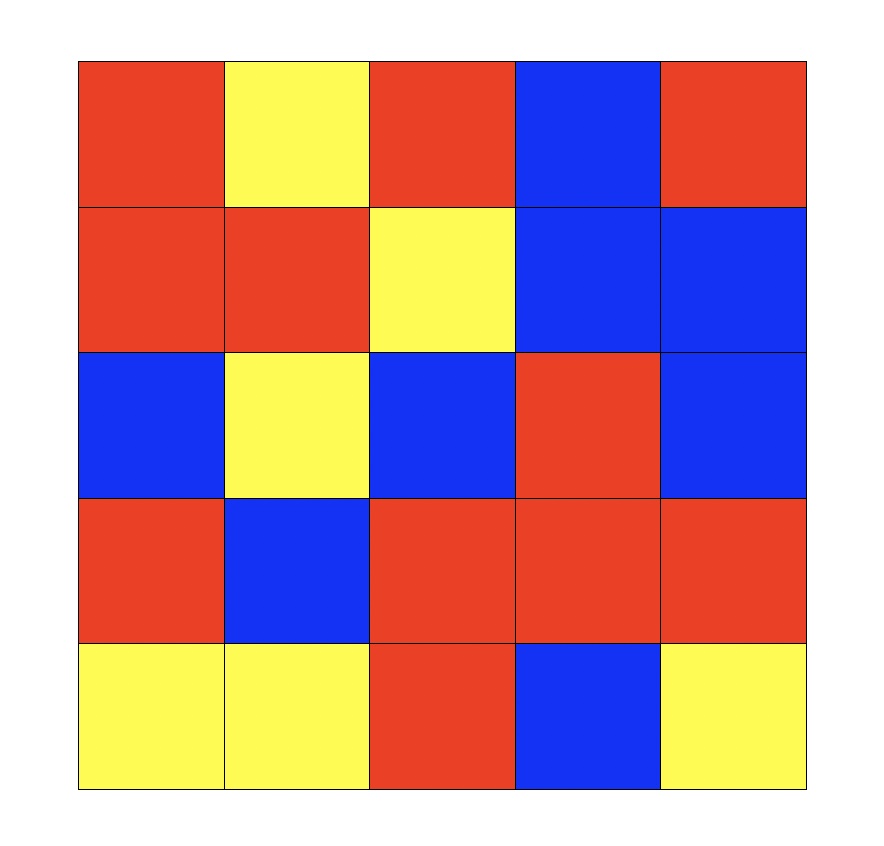
Figure 1: color block diagram

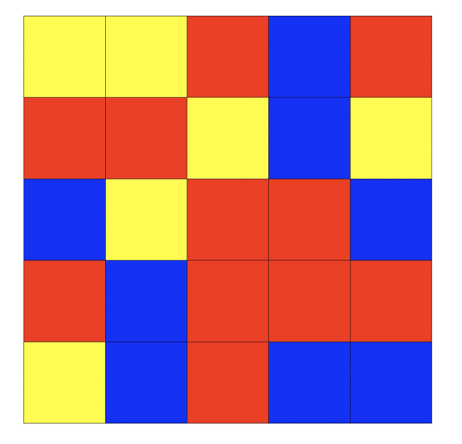
Figure 2: color block diagram (Changed)
2.3. Procedure
First, the participants will be told that they will take a psychological experiment about visual color. At the beginning of this experiment, every participant will get a color block diagram and be asked which color blocks appeared most frequently in the picture. When they give the correct answer, they will be led into a room separately as the 10th speaker and get ready for the next questions with the 9 confederates. Everyone in this room will be shown a color block diagram which have 3 different colors on it and will be asked the same question as they did before, but they’ll only get two choices to choose this time: the correct answer and one of the two wrong answers. The participants will be told that they’ll have 5 minutes to think about this question. After 5 minutes, the host will ask everyone in this room to answer the questions in order, which make the participants could observe the other testers’ answer. When the confederates answering questions, some confederates will be asked to give the wrong answer. Finally, the participants will be given his/her answer. The host will collect the data, change the color block diagram, and ask the same question again. Every participant will repeat this process 15 times. Of the 15 experiments, the confederates in the first, second, sixth, and tenth experiments won’t give the wrong answer. The experimenter will observe the answers of the participants in every experiment and compare the differences between the answers given by different groups of participants. After the experiments, the participants will be explained the whole process and learn that they had been deceived at the beginning of this experiment.
2.4. Data analysis
A correlational analysis will be used to test the relationship between exposure to social media and conformity levels. The assumptions we make is like the bar graph below (such as figure 3-5). The number of incorrect answers the participants gave increased as their addiction to social media increased, which proves what we suspected. On the opposite, the number of incorrect answers the participants gave decreased as their addiction to social media increased, which will refute our assumption. However, if the final data like the figure 5, the number of incorrect answers did not change as their addiction level on social media increased. That means there is no relationship between the social media addiction level and conformity tendency.
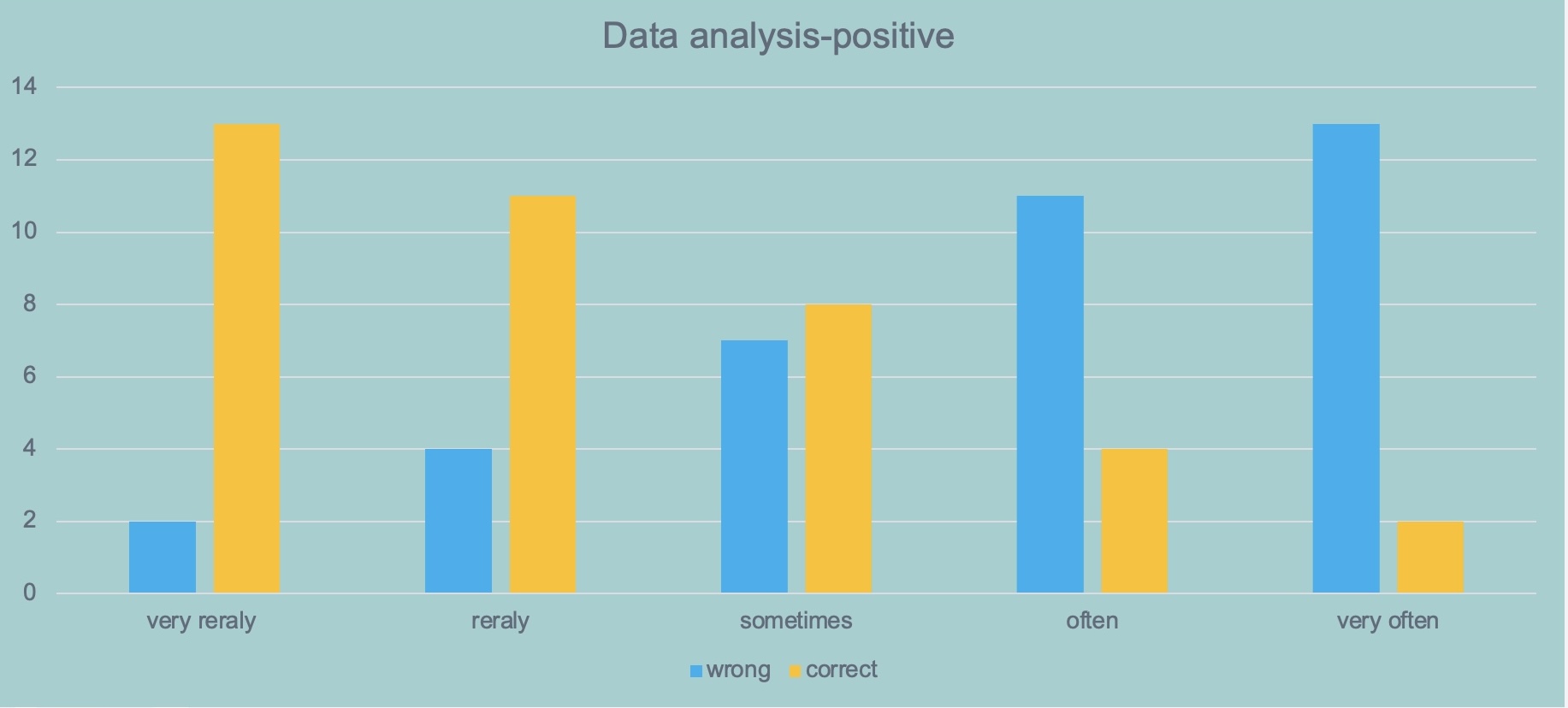
Figure 3: Data analysis-positive
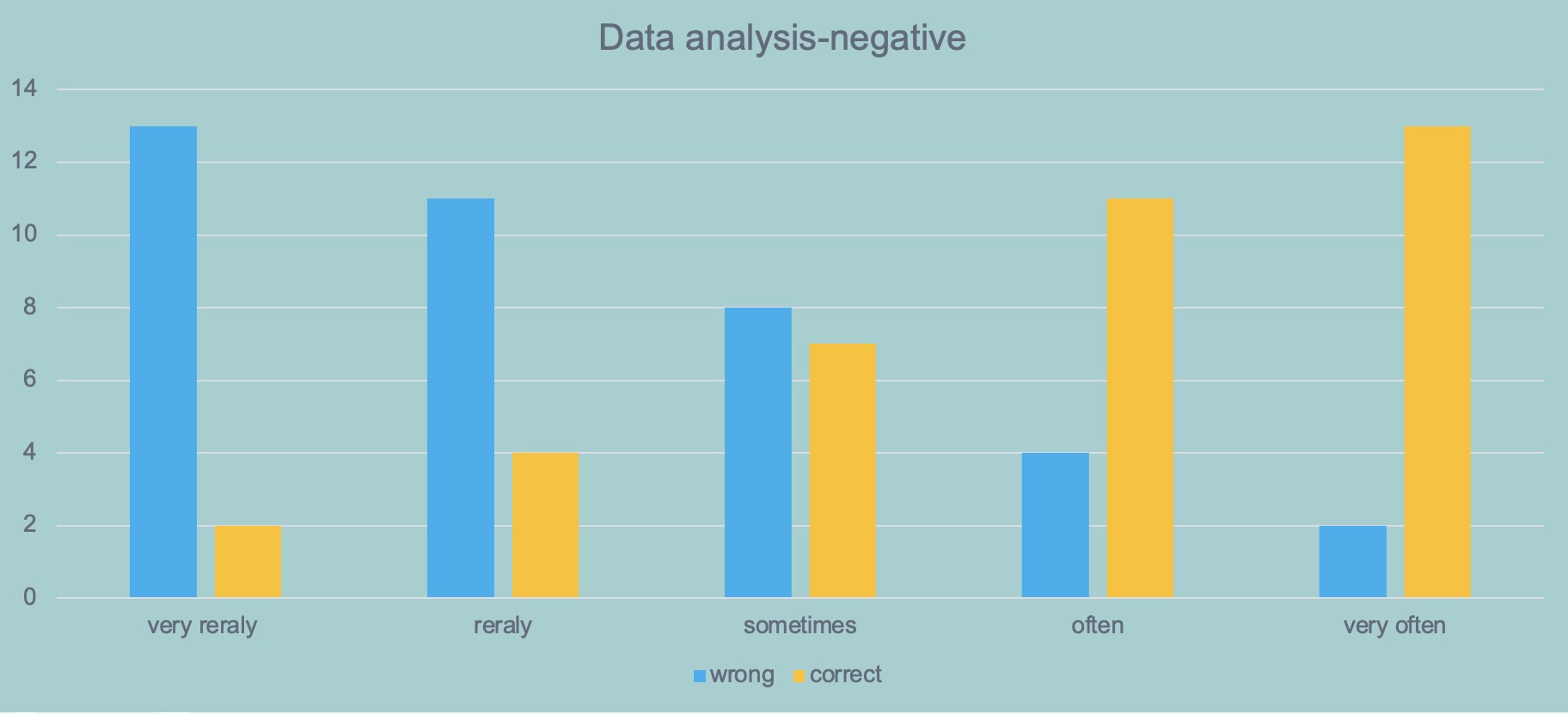
Figure 4: Data analysis-negative
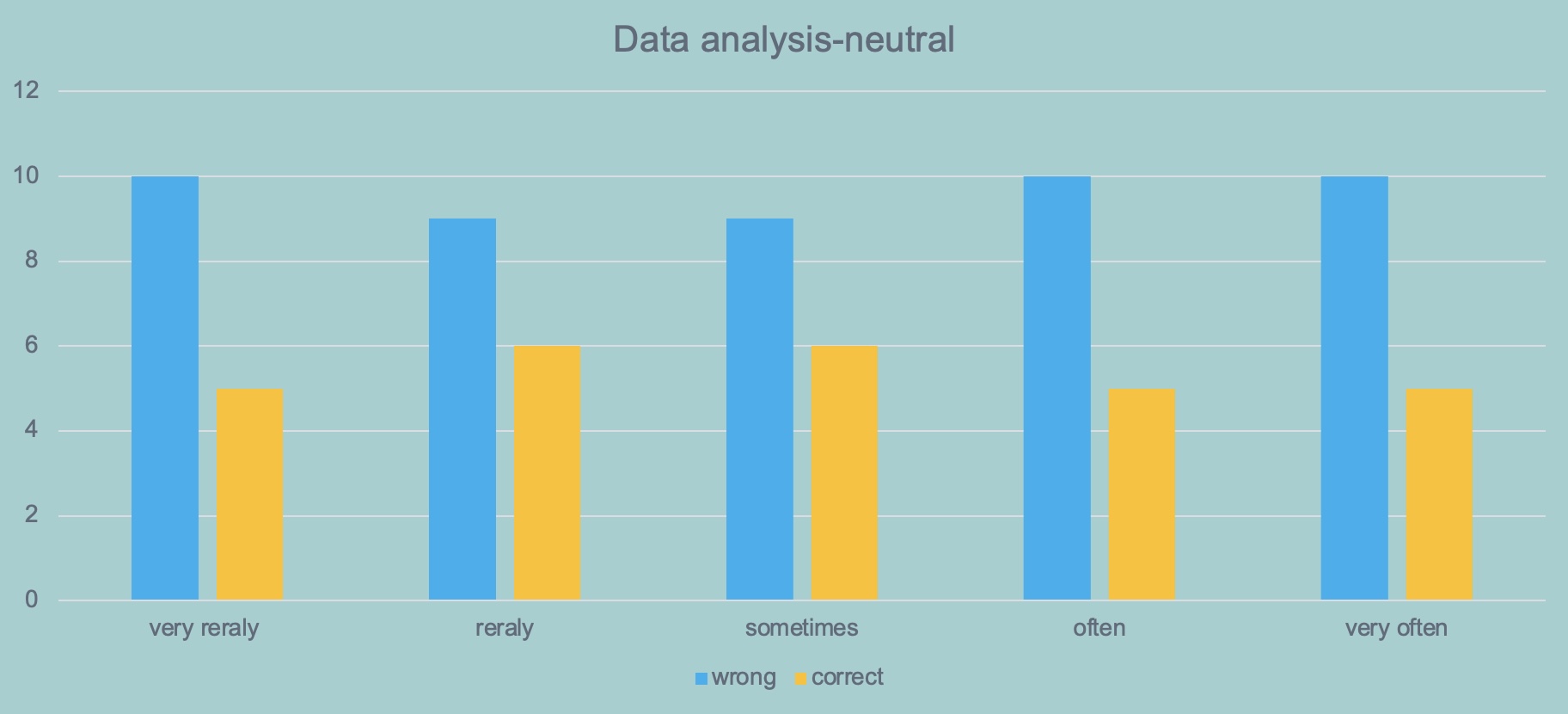
Figure 5: Data analysis-neutral
3. Discussion
3.1. The Relationship Between Social Media Addiction and Conformity
According to the experiment design, in order to prove our hypothesis is right, the correlation between the degree of addiction and the number of people who said the wrong answer should be downward sloping, so as the degree of addiction is rising, fewer people are enough for them to convincing the wrong answer. In this case, it can be concluded that the behavior of addiction has a positive correlation with the conformity of the majority of people.
To explain the possible results, here is the definition of the word "addiction", said by Soper and Miller [14], it involves in the behavior of lacking the interest to other things and some mental symptoms [15]. He also indicates six symptoms used to diagnose the addiction to certain objects. People with addiction to social media will think that social platforms are the most important thing in their lives and their emotions will be affected by social media constantly. So as the time they use social media increases and accumulates, they spend more time spending on social media to reach their expectations, to be more specific, they will browse social platforms like TikTok for longer time than before for the sake of looking for more videos that fit their taste. As soon as they stop using social media for a long time, the truncation reaction will appear to them, and the feeling of being agitated and bored will hasten them to pick up the phone again. In addition, social media damages and destroys interpersonal relationships and negatively affects everyday activities, as people lose themselves subjectively, also known as conformity to others. Even though they get away from social media for some time successfully, they will fall into the tendency to be addicted to social media over again.[16]
On the other hand, the meaning of conformity is already demonstrated [17] that people are trying to acquire information by observing others, so they intend to imitate those who seemingly know more about the current situation. 58% of people tend to believe what most people think about the article on social media [18], especially under the circumstances of losing self-confidence and when the majority of people challenge the reliability of the information. Despite the truth, most people would rather conform to the most popular explanation held by the majority.
From an early age, socialization processes play a crucial role in shaping our values and codes of conduct, encouraging us to adhere to societal norms and avoid criticism and rejection Conformity is a fundamental aspect of human behavior, driven by the inherent social nature of humans and their desire for acceptance and recognition within society.[19]Conformity serves as a mechanism for achieving social acceptance; by aligning our behaviors and opinions with those of others, we experience a sense of belonging and avoid social exclusion.[20]Starting at an early age, socialization processes play a crucial role in shaping our values and codes of conduct. As a result, they tend to follow the accepted patterns of behavior in society to avoid criticism and rejection. When faced with complex situations and large amounts of information, people often tend to follow the crowd to simplify the decision-making process. By observing the behaviors and opinions of others, we can gain quick reference and guidance, reduce cognitive load and decrease uncertainty in decision-making. [21] Social pressure significantly to conformity, as individuals seek to avoid being isolated, ostracized, or criticized, so they choose to conform with others. This pressure can come from a variety of sources such as family, peers, and the media. Moreover, conformity provides a sense of security and belonging. When individuals align ourselves with others, they feel integrated into a community that shares similar values and interests with others. This sense of belonging offers emotional support and security. [22]
3.2. The Impact of Social Media Addiction and Conformity on Society
Addiction and conformity can cause serious problems in public society. Social media will deplete workers' energy for work and creative ideas, make them listless for work.[23]. The decrease in work efficiency will lead to the mark time of social progress. Apart from that, conformity of incorrect information on the internet would distort facts. This will lead to damage to those who are been caught up in public opinion, it would be an attack on not only their reputation but also their mind and body. When more and more people believe and spread the mistaken truth, the pressure of public opinion would bring pain and suffering to those innocent people, which is not appropriate for the stabilization and harmonious development of society.
People tend to conform with others, especially on virtual social media networks, and by engaging and discussing the more enigmatic networks, they may feel a feeling of belonging with the group as shown in [24]. As highlighted by Gureckis [25] and Granovetter [26], information on the Internet is sometimes incomplete, vague or difficult to understand. This unpredictability may lead people to be more susceptible to herd mentality, as they rely on the opinions and behaviors of others to fill in the gaps in information. Additionally, People are influenced by the views and behaviors of others on social media, feeling compelled to follow the dominant opinions or actions to avoid ostracized or isolated [27]. Social networks also facilitate the observation and imitation of other’s behavior. When an idea or behavior is widely disseminated within a social network, it is more likely to be accepted and adopted by others, creating a group dynamic that motivates more people to follow the crowd.
Reasons why the modern web is more likely to create a herd mentality than the web of a decade or so ago. The popularity and popularity of social media has made people more easily influenced by others and the proliferation of opinions. The functions of liking, sharing and commenting on social media platforms make it easier for people to be recognized and endorsed by others, thus reinforcing the tendency of herd mentality. The herd effect is even more pronounced on modern networks. When people see a large number of people supporting a certain point of view or participating in a certain behavior, they will be more inclined to join in, so as to avoid going against the mainstream view or being isolated. This group effect is more likely to be amplified and spread on the Internet, thus adding to people's herd mentality. The vast amount of information in the modern network exposes people to more choices and views. However, due to information overload, people are often only able to browse and access a small portion of information rather than a full understanding. This leads to a greater tendency to choose information that has already been heavily disseminated and accepted, thus reinforcing the tendency to follow the herd mentality. The rapid dissemination and diffusion characteristics of modern networks allow information to spread rapidly to a large number of people in a short period of time. When people see that a particular message is being spread in large numbers, they are more likely to believe and follow it in order to avoid the possibility of having disagreements with others or missing important information.
3.3. Other theories to explain Conformity and Social Media Addiction: Social Order and Individuality
Here the circumstances when the data collected in the experiment failed to support the hypothesis are discussed. That is, on the graph, the correlation between the degree of addiction and the conformity threshold (number of people who said the wrong answer needed for the participant to conform) is not negative.
3.4. Individuality resulted from Social Media Addiction
Conformity may not be a byproduct of an adaptation designed for collecting more information. Feldman [28] proposed that conformity is a mechanism to enforce social order and avoid social disorder, and social order is a value opposite to individuality in most contexts. The main function of some social platforms, such as X (formally Twitter), Instagram or Weibo, is displaying the users themselves to others. If that is the case, addicts to these social medias probably love to display themselves. This suggests that they may have a strong sense of individuality. Their values may cause them to have a low probability to conform. This may result in an positive correlation between social media addiction level and conformity threshold.
3.5. Applying the Self-escape theory of Suicide to explain Social Media Addiction
The Self-escape theory of suicide [29] proposes that when the current situations fall far below an individual’s expectations, his/her self-awareness may generate negative emotions and reactions via means like self-attribution, blame and comparison. To alleviate negative emotions and reactions, the individual may desire to escape from their self-awareness. They may shift from a sane state to a “numb” state, or they may try the last resort -- suicide. Here we try to apply this idea to social media addiction. Using social media may be a method the addicts use to escape from their self-awareness. However, their addiction may have no relationship with information seeking or reward circuits. The act of using social media itself may be enough for the escape to happen. Therefore, tests on these kinds of addicts may not show a relationship between social media addiction level and conformity, which we hypothesized as a byproduct of an adaptation to receive more information.
3.6. Experimental Limitations: Multi-Question Design
Our multi-question design may be a demand characteristic. On one hand it enables us to determine the exact conformity threshold of the participants. But on the other hand, it gives the participants a cue of the purpose of our experiment. They may alter their behavior to conform to our expectations. It may cause a largely randomized result.
3.7. Experimental Limitations: BSMAS, a Self-Report
Our important experiment material, the BSMAS Scale, is a self-report that is not quantitative. It asks the participants themselves to evaluate their social media addiction level. This leaves a possibility of response bias. We cannot exclude the odd that some people may respond in a way they think is socially acceptable rather than true. This may randomize our results.
4. Conclusion
If the result matches the assumption that with higher level of addiction to social media people show higher level of conformity, we can summarize that the more addicted to the internet, the more people's conformity is raised because of people's groupthink as well as the wide spread of the internet. No one will want to be the special one, and people will rely more on existing evidence rather than looking for new reasons to explain a new one. Also, the addiction to social media will influence our normal life more through the time. On the other hand, if the data collected in the experiment failed to support the hypothesis, it could be caused by (a) that individuality resulted from Social Media Addiction impeded participants to conform, (b)that Social Media Addiction is not related to information seeking or reward mechanisms, (c) that the multi-question design informed participants the purpose of this experiment, and (d) response bias in the self-report BSMAS scale.
Acknowledgement
Weixuan Ding, Yuxuan Song, He Zhang, Yinuo Wang and Yiran Chen contributed equally to this work and should be considered co-first authors.
References
[1]. Social Media Addiction Statistics—Risks, Warnings & Safety (2024). (2024, July 17). AddictionHelp.Com. https://www.addictionhelp.com/social-media-addiction/statistics/
[2]. Lewandowsky, S., Ecker, U. K. H., & Cook, J. (2017). Beyond Misinformation: Understanding and Coping with the “Post-Truth” Era. Journal of Applied Research in Memory and Cognition, 6(4), 353–369. https://doi.org/10.1016/j.jarmac.2017.07.008
[3]. Calvey, T. (2017). Chapter 1 - The extended evolutionary synthesis and addiction: The price we pay for adaptability. In T. Calvey & W. M. U. Daniels (Eds.), Progress in Brain Research (Vol. 235, pp. 1–18). Elsevier. https://doi.org/10.1016/bs.pbr.2017.07.004
[4]. Ouzir, M., & Errami, M. (2016). Etiological theories of addiction: A comprehensive update on neurobiological, genetic and behavioural vulnerability. Pharmacology Biochemistry and Behavior, 148, 59–68. https://doi.org/10.1016/j.pbb.2016.06.005g
[5]. Aquili, L. (2014). The causal role between phasic midbrain dopamine signals and learning. Frontiers in Behavioral Neuroscience, 8. https://doi.org/10.3389/fnbeh.2014.00139
[6]. Beeler, J. A., Cools, R., Luciana, M., Ostlund, S. B., & Petzinger, G. (2014). A kinder, gentler dopamine… highlighting dopamine’s role in behavioral flexibility. Frontiers in Neuroscience, 8. https://doi.org/10.3389/fnins.2014.00004
[7]. The Pandora Effect: The Power and Peril of Curiosity—Christopher K. Hsee, Bowen Ruan, 2016. (n.d.). Retrieved July 19, 2024, from https://journals.sagepub.com/doi/abs/10.1177/0956797616631733
[8]. Borhaneddine, B. (2023). The Impact of Social Media Addiction on Students’ Critical Thinking. [Thesis, university center of abdalhafid boussouf - MILA]. http://dspace.centre-univ-mila.dz/jspui/handle/123456789/2490
[9]. Bernheim, B. D. (1994). A Theory of Conformity. Journal of Political Economy, 102(5), 841–877. https://doi.org/10.1086/261957
[10]. Akerlof, G. A. (1980). A Theory of Social Custom, of which Unemployment may be One Consequence*. The Quarterly Journal of Economics, 94(4), 749–775. https://doi.org/10.2307/1885667
[11]. Jones, S. R. G. (n.d.). The economics of conformism. (No Title). Retrieved July 23, 2024, from https://cir.nii.ac.jp/crid/1130000796871964160
[12]. Willis, R. H. (1965). Conformity, independence, and anticonformity. Human Relations, 18(4), 373-388. Retrieved July 25, 2024, from https://journals.sagepub.com/doi/10.1177/001872676501800406
[13]. Bergen Social Media Addiction Scale. (n.d.). Blocksurvey.Io. Retrieved July 22, 2024, from https://blocksurvey.io/survey/t/410447c4-ccf0-47dc-be54-df958e27e7d5/r/o
[14]. Soper, W. B., & Miller, M. J. (1983). Junk-Time Junkies: An Emerging Addiction Among Students. The School Counselor, 31(1), 40–43. https://www.jstor.org/stable/23900931
[15]. COVENTRY, K. R., & BROWN, R. I. F. (1993). Sensation seeking, gambling and gambling addictions. Addiction, 88(4), 541–554. https://doi.org/10.1111/j.1360-0443.1993.tb02061.x
[16]. Griffiths, M. (1996). Behavioural addiction: an issue for everybody? Employee Counselling Today, 8(3), 19–25. https://doi.org/10.1108/13665629610116872
[17]. Welch, I. (2024). Information Cascades in Banerjee (1992), Bikhchandani, Hirshleifer, and Welch (1992), and Welch (1992). Social Science Research Network. https://doi.org/10.2139/ssrn.4779644
[18]. Wijenayake, S., Hettiachchi, D., Hosio, S. J., Kostakos, V., & Goncalves, J. (2020). Effect of Conformity on Perceived Trustworthiness of News in Social Media. IEEE Internet Computing, 25(1), 1–1. https://doi.org/10.1109/MIC.2020.3032410
[19]. Tajfel, Henri, and John Turner. The Social Identity Theory of Intergroup Behavior . 1986.
[20]. McLeod, Saul. “Albert Bandura’s Social Learning Theory.” Simply Psychology, 1 Feb. 2024, www.simplypsychology.org/bandura.html.
[21]. Asch, Solomon, and Harold Guetzkow. “Group Pressure upon the Modification and Distortion of Judgements.” S. E. Asch, Social Psychology, vol. 1, no. 1, 1951, gwern.net/doc/psychology/1952-asch.pdf.
[22]. Zivnuska, S., Carlson, J. R., Carlson, D. S., Harris, R. B., & Harris, K. J. (2019). Social media addiction and social media reactions: The implications for job performance. The Journal of Social Psychology, 159(6), 746–760. https://doi.org/10.1080/00224545.2019.1578725
[23]. Festinger, Leon. “A Theory of Social Comparison Processes.” Human Relations, vol. 7, no. 2, May 1954, pp. 117–140, https://doi.org/10.1177/001872675400700202
[24]. T, Postmes, and Spears R. “APA PsycNet.” Apa.org, 2024, psycnet.apa.org/record/2002-17436-006. Accessed 23 Aug. 2024.
[25]. Goldstone, Robert L., and Todd M. Gureckis. “Collective Behavior.” Topics in Cognitive Science, vol. 1, no. 3, July 2009, pp. 412–438, https://doi.org/10.1111/j.1756-8765.2009.01038.x.
[26]. Granovetter, Mark. “Threshold Models of Collective Behavior.” American Journal of Sociology, vol. 83, no. 6, 1978, pp. 1420–1443, www.jstor.org/stable/2778111.
[27]. R, Bond, and Smith P. B. “APA PsycNet.” Psycnet.apa.org, 1996, psycnet.apa.org/record/1996-01401-008.
[28]. Feldman, S. (2003). Enforcing Social Conformity: A Theory of Authoritarianism. Political Psychology, 24(1), 41–74. https://doi.org/10.1111/0162-895x.00316
[29]. Baumeister, R. F. (1990). Suicide as escape from self. Psychological Review, 97(1), 90–113. https://doi.org/10.1037/0033-295x.97.1.90
Cite this article
Ding,W.;Song,Y.;Zhang,H.;Wang,Y.;Chen,Y. (2025). Exploring the Relationship Between Social Media Exposure and Levels of Conformity: An Evolutionary Analysis. Communications in Humanities Research,55,171-179.
Data availability
The datasets used and/or analyzed during the current study will be available from the authors upon reasonable request.
Disclaimer/Publisher's Note
The statements, opinions and data contained in all publications are solely those of the individual author(s) and contributor(s) and not of EWA Publishing and/or the editor(s). EWA Publishing and/or the editor(s) disclaim responsibility for any injury to people or property resulting from any ideas, methods, instructions or products referred to in the content.
About volume
Volume title: Proceedings of 3rd International Conference on Interdisciplinary Humanities and Communication Studies
© 2024 by the author(s). Licensee EWA Publishing, Oxford, UK. This article is an open access article distributed under the terms and
conditions of the Creative Commons Attribution (CC BY) license. Authors who
publish this series agree to the following terms:
1. Authors retain copyright and grant the series right of first publication with the work simultaneously licensed under a Creative Commons
Attribution License that allows others to share the work with an acknowledgment of the work's authorship and initial publication in this
series.
2. Authors are able to enter into separate, additional contractual arrangements for the non-exclusive distribution of the series's published
version of the work (e.g., post it to an institutional repository or publish it in a book), with an acknowledgment of its initial
publication in this series.
3. Authors are permitted and encouraged to post their work online (e.g., in institutional repositories or on their website) prior to and
during the submission process, as it can lead to productive exchanges, as well as earlier and greater citation of published work (See
Open access policy for details).
References
[1]. Social Media Addiction Statistics—Risks, Warnings & Safety (2024). (2024, July 17). AddictionHelp.Com. https://www.addictionhelp.com/social-media-addiction/statistics/
[2]. Lewandowsky, S., Ecker, U. K. H., & Cook, J. (2017). Beyond Misinformation: Understanding and Coping with the “Post-Truth” Era. Journal of Applied Research in Memory and Cognition, 6(4), 353–369. https://doi.org/10.1016/j.jarmac.2017.07.008
[3]. Calvey, T. (2017). Chapter 1 - The extended evolutionary synthesis and addiction: The price we pay for adaptability. In T. Calvey & W. M. U. Daniels (Eds.), Progress in Brain Research (Vol. 235, pp. 1–18). Elsevier. https://doi.org/10.1016/bs.pbr.2017.07.004
[4]. Ouzir, M., & Errami, M. (2016). Etiological theories of addiction: A comprehensive update on neurobiological, genetic and behavioural vulnerability. Pharmacology Biochemistry and Behavior, 148, 59–68. https://doi.org/10.1016/j.pbb.2016.06.005g
[5]. Aquili, L. (2014). The causal role between phasic midbrain dopamine signals and learning. Frontiers in Behavioral Neuroscience, 8. https://doi.org/10.3389/fnbeh.2014.00139
[6]. Beeler, J. A., Cools, R., Luciana, M., Ostlund, S. B., & Petzinger, G. (2014). A kinder, gentler dopamine… highlighting dopamine’s role in behavioral flexibility. Frontiers in Neuroscience, 8. https://doi.org/10.3389/fnins.2014.00004
[7]. The Pandora Effect: The Power and Peril of Curiosity—Christopher K. Hsee, Bowen Ruan, 2016. (n.d.). Retrieved July 19, 2024, from https://journals.sagepub.com/doi/abs/10.1177/0956797616631733
[8]. Borhaneddine, B. (2023). The Impact of Social Media Addiction on Students’ Critical Thinking. [Thesis, university center of abdalhafid boussouf - MILA]. http://dspace.centre-univ-mila.dz/jspui/handle/123456789/2490
[9]. Bernheim, B. D. (1994). A Theory of Conformity. Journal of Political Economy, 102(5), 841–877. https://doi.org/10.1086/261957
[10]. Akerlof, G. A. (1980). A Theory of Social Custom, of which Unemployment may be One Consequence*. The Quarterly Journal of Economics, 94(4), 749–775. https://doi.org/10.2307/1885667
[11]. Jones, S. R. G. (n.d.). The economics of conformism. (No Title). Retrieved July 23, 2024, from https://cir.nii.ac.jp/crid/1130000796871964160
[12]. Willis, R. H. (1965). Conformity, independence, and anticonformity. Human Relations, 18(4), 373-388. Retrieved July 25, 2024, from https://journals.sagepub.com/doi/10.1177/001872676501800406
[13]. Bergen Social Media Addiction Scale. (n.d.). Blocksurvey.Io. Retrieved July 22, 2024, from https://blocksurvey.io/survey/t/410447c4-ccf0-47dc-be54-df958e27e7d5/r/o
[14]. Soper, W. B., & Miller, M. J. (1983). Junk-Time Junkies: An Emerging Addiction Among Students. The School Counselor, 31(1), 40–43. https://www.jstor.org/stable/23900931
[15]. COVENTRY, K. R., & BROWN, R. I. F. (1993). Sensation seeking, gambling and gambling addictions. Addiction, 88(4), 541–554. https://doi.org/10.1111/j.1360-0443.1993.tb02061.x
[16]. Griffiths, M. (1996). Behavioural addiction: an issue for everybody? Employee Counselling Today, 8(3), 19–25. https://doi.org/10.1108/13665629610116872
[17]. Welch, I. (2024). Information Cascades in Banerjee (1992), Bikhchandani, Hirshleifer, and Welch (1992), and Welch (1992). Social Science Research Network. https://doi.org/10.2139/ssrn.4779644
[18]. Wijenayake, S., Hettiachchi, D., Hosio, S. J., Kostakos, V., & Goncalves, J. (2020). Effect of Conformity on Perceived Trustworthiness of News in Social Media. IEEE Internet Computing, 25(1), 1–1. https://doi.org/10.1109/MIC.2020.3032410
[19]. Tajfel, Henri, and John Turner. The Social Identity Theory of Intergroup Behavior . 1986.
[20]. McLeod, Saul. “Albert Bandura’s Social Learning Theory.” Simply Psychology, 1 Feb. 2024, www.simplypsychology.org/bandura.html.
[21]. Asch, Solomon, and Harold Guetzkow. “Group Pressure upon the Modification and Distortion of Judgements.” S. E. Asch, Social Psychology, vol. 1, no. 1, 1951, gwern.net/doc/psychology/1952-asch.pdf.
[22]. Zivnuska, S., Carlson, J. R., Carlson, D. S., Harris, R. B., & Harris, K. J. (2019). Social media addiction and social media reactions: The implications for job performance. The Journal of Social Psychology, 159(6), 746–760. https://doi.org/10.1080/00224545.2019.1578725
[23]. Festinger, Leon. “A Theory of Social Comparison Processes.” Human Relations, vol. 7, no. 2, May 1954, pp. 117–140, https://doi.org/10.1177/001872675400700202
[24]. T, Postmes, and Spears R. “APA PsycNet.” Apa.org, 2024, psycnet.apa.org/record/2002-17436-006. Accessed 23 Aug. 2024.
[25]. Goldstone, Robert L., and Todd M. Gureckis. “Collective Behavior.” Topics in Cognitive Science, vol. 1, no. 3, July 2009, pp. 412–438, https://doi.org/10.1111/j.1756-8765.2009.01038.x.
[26]. Granovetter, Mark. “Threshold Models of Collective Behavior.” American Journal of Sociology, vol. 83, no. 6, 1978, pp. 1420–1443, www.jstor.org/stable/2778111.
[27]. R, Bond, and Smith P. B. “APA PsycNet.” Psycnet.apa.org, 1996, psycnet.apa.org/record/1996-01401-008.
[28]. Feldman, S. (2003). Enforcing Social Conformity: A Theory of Authoritarianism. Political Psychology, 24(1), 41–74. https://doi.org/10.1111/0162-895x.00316
[29]. Baumeister, R. F. (1990). Suicide as escape from self. Psychological Review, 97(1), 90–113. https://doi.org/10.1037/0033-295x.97.1.90









